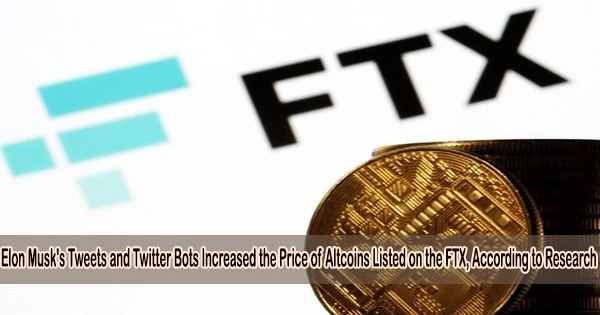The price of cryptocurrencies, including those traded by insiders at FTX hedge firm Alameda Research before its collapse, rose as a result of rampant bot activity on Twitter, according to a new study from the Network Contagion Research Institute released on Wednesday (August 2, 2023).
NCRI researchers conducted a scaled analysis on Twitter (now known as X) examining over 3 million tweets from Jan. 1, 2019, to Jan. 27, 2023, pertaining to 18 different cryptocurrencies in partnership with New Jersey GovSTEM Scholars. They also shared their findings with X Corp. days ahead of publication.
Elon Musk, CEO of Tesla and SpaceX, who oversaw the acquisition of Twitter, which was completed in October, seems to have mentioned specific altcoins, causing price spikes of up to 50% within a single day, according to the researchers.
The NCRI study pointed to Musk’s June 24, 2023, retweet of a post featuring a kitten and the caption, “I wake up there is another PSYOP,” a coin created by a pseudonymous Twitter influencer known as Ben.eth. Trading of this altcoin nearly doubled in volume over the next day, according to CoinMarketCap data.
Separately, a Musk tweet on May 13, 2023, featuring Pepe the Frog memes led to a more than 50% increase in the price of altcoin PEPE within 24 hours. Musk’s post sparked real conversation about the altcoin, which is based on a well-known far-right meme, as well as automated and promotional tweets about it.
The NCRI findings raise important concerns regarding market manipulation caused by social media in the larger crypto marketplaces. The report also emphasizes how difficult it will be for Musk to control bot activity that has been ubiquitous on social media for years and continues to exist there.
Musk has claimed, without providing data, that bot activity has fallen since he acquired Twitter.
People on crypto Twitter, or other sort of similar parties, go and put $200 million in the box collectively. In the world we’re in, if you do this, everyone’s gonna be like, ‘Ooh, box token. Maybe it’s cool. If you buy in box token,’ you know, that’s gonna appear on Twitter and it’ll have a $20 million market cap.
Bankman-Fried
According to Alex Goldenberg, Lead Intelligence Analyst for NCRI, “Since Musk’s team took over Twitter last year, API changes were made to deter bot creation, possibly reducing crypto promotion and scams. However, these changes come with trade-offs as they also hinder independent audits by third-party researchers.”
Goldenberg recommends that if bot activity remains high, X Corp. could “consider stricter account verification, machine learning for bot detection, and special permissions for certified researchers to ensure transparency while combating malicious bot activity and other forms of online harm.”
In addition to raising the cost of data access for academics, X Corp. has also threatened and filed litigation against anyone who investigate hate speech and other online damages on its platform. In recent weeks, X Corp. sued Bright Data and the Center for Countering Digital Hate, for example, raising the ire of House Democrats. NCRI partners with Bright Data for pro-bono access to social media data, Goldenberg noted.
X Corp. did not immediately respond to a request for comment.
FTX benefitted greatly from Twitter bot activity
The NCRI study also highlights how inauthentic activity on Twitter helped drive up the price of tokens listed on FTX in the months before the crypto exchange collapsed. “Bot-like accounts were used to manipulate market sentiment and drive up the price of FTX-listed tokens,” Goldenberg told CNBC in an interview.
Six small-cap tokens listed by FTX were significantly influenced by inauthentic social media activity on Twitter, NCRI found. The researchers said that “inauthentic chatter” was “successfully and deliberately deployed to influence changes in FTX coin prices,” for six tokens: BOBA, GALA, IMX, RNDR, and SPELL.
Alameda held at least five of these tokens before they were listed on FTX, and as bot-like activity on Twitter amplified the visibility of the tokens. For one crypto asset, RNDR, inauthentic posts and activity on Twitter concurred with or preceded double-digit percentage jumps in its price.
On four separate dates from 2022 to 2023, spikes in bot activity on Twitter preceded increases in RNDR’s price ranging from 11% to 30% within a single day, the NCRI analysis found.
FTX founder Sam Bankman-Fried and his team were well aware of Twitter’s influence on the crypto markets, and how sophisticated investors could extract value from social-media driven price action.
“People on crypto Twitter, or other sort of similar parties, go and put $200 million in the box collectively,” Bankman-Fried said in an 2022 interview on Bloomberg’s Odd Lots podcast. “In the world we’re in, if you do this, everyone’s gonna be like, ‘Ooh, box token. Maybe it’s cool. If you buy in box token,’ you know, that’s gonna appear on Twitter and it’ll have a $20 million market cap.”
FTX was one of the largest crypto exchanges in the world before it filed for bankruptcy in 2022.
Bankman-Fried, 31, now faces a federal indictment for allegedly committing securities and wire fraud. He’s also the subject of Securities and Exchange Commission charges, which alleges that he built his empire on a “foundation of deception.”
Representatives for Bankman-Fried declined to comment. The SEC and FTX did not immediately respond to a request for comment.
















